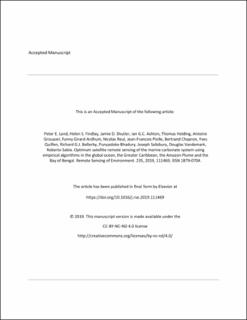| dc.contributor.author | Land, Peter E | |
| dc.contributor.author | Findlay, Helen S | |
| dc.contributor.author | Shutler, Jamie D | |
| dc.contributor.author | Ashton, Ian G C | |
| dc.contributor.author | Holding, Thomas | |
| dc.contributor.author | Grouazel, Antoine | |
| dc.contributor.author | Girard-Ardhuin, Fanny | |
| dc.contributor.author | Reul, Nicolas | |
| dc.contributor.author | Jean-Francois, Piolle | |
| dc.contributor.author | Chapron, Bertrand | |
| dc.contributor.author | Quilfen, Yves | |
| dc.contributor.author | Bellerby, Richard G J | |
| dc.contributor.author | Bhadbury, Punyasloke | |
| dc.contributor.author | Salisbury, Joseph | |
| dc.contributor.author | Vandemark, Douglas | |
| dc.contributor.author | Sabia, Roberto | |
| dc.date.accessioned | 2020-06-29T08:47:00Z | |
| dc.date.available | 2020-06-29T08:47:00Z | |
| dc.date.created | 2019-11-28T14:03:45Z | |
| dc.date.issued | 2019 | |
| dc.identifier.citation | Remote Sensing of Environment. 2019, 235, 111469. | en_US |
| dc.identifier.issn | 0034-4257 | |
| dc.identifier.uri | https://hdl.handle.net/11250/2659806 | |
| dc.description | Embargo until 08 November 2021 | en_US |
| dc.description.abstract | Improving our ability to monitor ocean carbonate chemistry has become a priority as the ocean continues to absorb carbon dioxide from the atmosphere. This long-term uptake is reducing the ocean pH; a process commonly known as ocean acidification. The use of satellite Earth Observation has not yet been thoroughly explored as an option for routinely observing surface ocean carbonate chemistry, although its potential has been highlighted. We demonstrate the suitability of using empirical algorithms to calculate total alkalinity (AT) and total dissolved inorganic carbon (CT), assessing the relative performance of satellite, interpolated in situ, and climatology datasets in reproducing the wider spatial patterns of these two variables. Both AT and CT in situ data are reproducible, both regionally and globally, using salinity and temperature datasets, with satellite observed salinity from Aquarius and SMOS providing performance comparable to other datasets for the majority of case studies. Global root mean squared difference (RMSD) between in situ validation data and satellite estimates is 17 μmol kg−1 with bias < 5 μmol kg−1 for AT and 30 μmol kg−1 with bias < 10 μmol kg−1 for CT. This analysis demonstrates that satellite sensors provide a credible solution for monitoring surface synoptic scale AT and CT. It also enables the first demonstration of observation-based synoptic scale AT and CT temporal mixing in the Amazon plume for 2010–2016, complete with a robust estimation of their uncertainty. | en_US |
| dc.language.iso | eng | en_US |
| dc.publisher | Elsevier | en_US |
| dc.rights | Attribution-NonCommercial-NoDerivatives 4.0 Internasjonal | * |
| dc.rights.uri | http://creativecommons.org/licenses/by-nc-nd/4.0/deed.no | * |
| dc.title | Optimum satellite remote sensing of the marine carbonate system using empirical algorithms in the global ocean, the Greater Caribbean, the Amazon Plume and the Bay of Bengal | en_US |
| dc.type | Peer reviewed | en_US |
| dc.type | Journal article | en_US |
| dc.description.version | acceptedVersion | en_US |
| dc.source.pagenumber | 15 | en_US |
| dc.source.volume | 235 | en_US |
| dc.source.journal | Remote Sensing of Environment | en_US |
| dc.identifier.doi | 10.1016/j.rse.2019.111469 | |
| dc.identifier.cristin | 1753845 | |
| dc.relation.project | ESA - den europeiske romfartsorganisasjonen: 4000112091/14/I-LG | en_US |
| dc.relation.project | ESA - den europeiske romfartsorganisasjonen: 4000110778/14/I-BG | en_US |
| cristin.ispublished | true | |
| cristin.fulltext | postprint | |
| cristin.qualitycode | 2 | |

